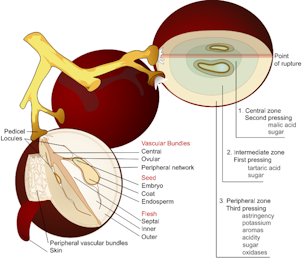The
structure of the grape berry may be roughly divided into three tissue
types: skin, flesh, and seed (Fig. 1). The chemical composition of
each of these tissues types differs, which strongly influences final
grape and grape product quality.

Fig. 1
 Cutaway image of a mature grape berry
Cutaway image of a mature grape berry
SkinThe
skin of the grape berry is also known as the exocarp. It is covered by
a waxy layer called the cuticle. Unlike some other plant surfaces, the
skin of a grape berry does not contain a significant number of
functional stomata. Therefore water loss occurs mostly through the waxy
cuticle, a relatively slow process. One consequence of this physiology
is that grape berries do not dissipate heat well via water evaporation.
Another consequence is that grape berries are not well able to shed
excess water quickly. Hence they are more susceptible to splitting
compared to some other fruits.
Just under the outer layer of
skin cells lies a tightly-packed layer of flattened cells called the
hypodermis. These cells tend to accumulate phenolic compounds in
relatively high concentrations as the grape berry matures. Among their
other effects, these compounds strongly influence aroma, flavor, and
color attributes. Therefore, they play a key role in determining final
juice and wine quality and sensory characteristics.
The
compounds concentrated in these cells include many types of tannins,
which strongly influence elements of mouthfeel such as astringency, and
flavor such as bitterness, and many specific flavor notes. Most of
these compounds are accumulated during early berry development, prior
to veraison. The per-berry concentration of tannins does not appear to
be much altered in the skin during the later stages of grape berry
maturation, but the chemical structure of the tannins is altered. These
changes lead to less astringency, less bitterness, and a smoother
mouthfeel.
Pigments, mainly anthocyanins in red grapes,
accumulate in these cells beginning at veraison. Many aromatic
compounds such as the terpenoids, responsible for pleasant, fruity
aromas, begin accumulating in these cells during this time as well.
In
“slip-skin” varieties of grapes, there is a breakdown during ripening
of the pectic materials that serve to bind together plant cell walls of
the cells that make up the flesh immediately below the hypodermal layer
of the skin. This allows the skin to separate readily from the berry
flesh in these varieties.
FleshThe
cells that make up grape berry flesh are typically larger and rounder
than the cells that make up the skin. These cells contain large
vacuoles, which are the primary sites for the accumulation of sugars
during grape berry ripening. As it enters the berry, sucrose that is
transported into the cells from the vine canopy is broken down into
glucose and fructose, which are the primary sugars found in mature
grape berries.
Acids and phenolic compounds are also
concentrated in these vacuoles, with the primary acids being tartaric
and malic acid. In contrast with those located in the skin, acids and
tannins located in the flesh tend to decline in per-berry concentration
during berry maturation. The concentration of malic acid in particular
tends to decrease. Tannins and acids present in these cells are
considerably diluted by the influx of water that occurs as the grape
berry matures.
The grape berry flesh cells divide rapidly until
about three weeks after flowering and the rate of division is
influenced by environmental factors. After cell division slows and
stops, there is a short lag phase when berry size is stagnant.
Following lag phase, cell size rapidly expands due to the engustment of
water into the berry and its cells. It is in this third phase of berry
growth that veraison occurs. Thus, fruit size in grapes is determined
by cell number and, predominantly by the enlargement of those cells in
the berry flesh that takes place as the grape matures. Vacuoles in
these cells expand or contract substantially in response to water
uptake or loss, particularly after veraison.
SeedsGrape
seeds are contained in locules (Fig. 1), which are indistinct in
mature berries. The seeds are composed of an outer seed coat, the
endosperm, and the embryo. As with most seeds, the endosperm comprises
the bulk of the grape seed and serves to nourish the embryo during
early growth.
As the seeds grow during fruit maturation, they
produce growth regulators that strongly influence fruit size. Thus, the
size of a particular grape berry is determined in part by the number of
fertilized seeds that develop within it.
The seed coat also
contains relatively high concentrations of tannins. Similar to the
tannins and phenols found in the flesh, these tannins are reduced in
concentration on a per-berry basis as the berries mature. In
particular, phenols responsible for bitterness are altered or rendered
less soluble/extractable.
Vascular tissuesDuring
its development, the grape berry obtains water and other nutrients
through its vascular system (Fig. 1). This system consists of central
bundles and a peripheral network.
Evidence suggests that xylem
vascular tissue is the primary source of grape berry nutrients until
veraison, but that ploem vascular tissue becomes the primary source
after veraison. Xylem serves to transport nutrients primarily from the
roots. These nutrients include minerals, hormones, and other compounds.
Phloem serves to transport nutrients primarily from the canopy; these
are mainly sugars, mostly sucrose. Thus, the changes in grape berry
vascular tissue seen during maturation correspond nicely to the
development cycle observed in the grape berry cells: most changes
observed in grape berry composition after veraison relate to the
accumulation of sugar and the influx of water from the phloem.
Reviewed by Sara Spayd, North Carolina State University and Jim Wolpert, UC Davis
